Why there’s no better way to zero in on B2B than LinkedIn Advertising
Designed specifically for professionals, LinkedIn is built from the ground up for delivering business-focused content to its community. Users provide high levels of information about their professional lives and LinkedIn advertising offers a wide range of targeting – providing everything you need to run B2B ads with pinpoint accuracy.
Unique, 360° coverage when it comes to reaching users.
While it’s frowned on to check your Facebook or Twitter accounts at work, LinkedIn is in a different category. This makes it possible to reach users who are checking LinkedIn before work, during, and after, with time-relevant messaging whether they are at the desktop or on a smartphone.
Plus, amazing targeting options and low CPM with LinedIn advertising
LinkedIn advertising offers two million targeting options, whose scope is remarkably diverse in terms of interests and viewpoints. And its CPM (Cost Per Thousand Impressions) is low: At an average price of $0.75, LinkedIn can be a highly cost-effective option.
LinkedIn Ads: Options and considerations
Before we get into your ad options, a few important considerations:
- Apply the best practices mentioned in our previous post: Define goals and metrics; create daily and lifetime budgets; research your audience and target appropriately; respect privacy concerns; stay on target.
- LinkedIn ads are much more affected by social sharing and ranking than on Facebook. Your Ad will have a much bigger effect when somebody shares it.
- LinkedIn advertising is very appropriate for companies with long sales cycles. Many advertisers use it to encourage people to interact with their brands to build awareness and legitimacy.
So what are your options for LinkedIn advertising? Essentially, there are two:
Basic ads and Sponsored Updates. Basic ads appear in the right-hand column of users’ feeds, as in the screen capture below. Sponsored Updates, as you see, appear in the middle of a user’s feed. Let’s begin by describing their advantages first.
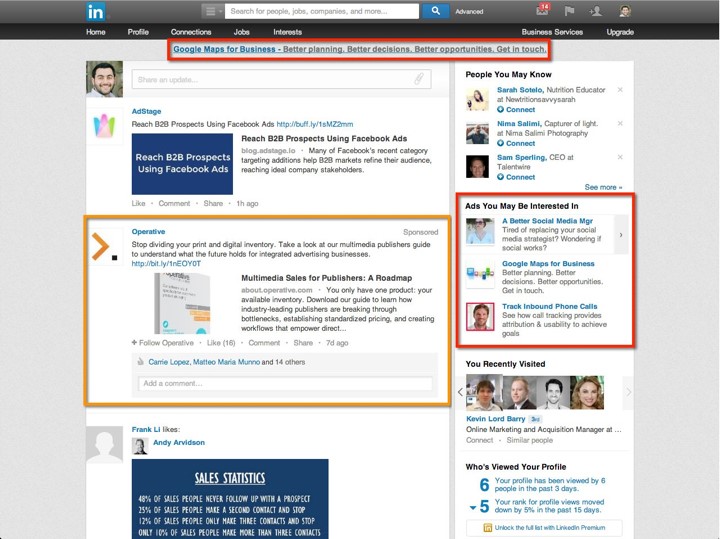
Sponsored Update is highlighted on the left. Basic ad is highlighted on the right.
Sponsored Updates. As users engage with content from news sites, professional connections and brands, Sponsored Updates bring you into the conversation front and center – posting right in the middle of their member feeds. You can combine text and visuals, and include videos. The only option for reaching mobile users, they appear in the member feeds on tablets and smartphones. Basic ads, because of their placement in the right column, won’t show up.
Important Note: You first need a Company Page to create Sponsored Updates!
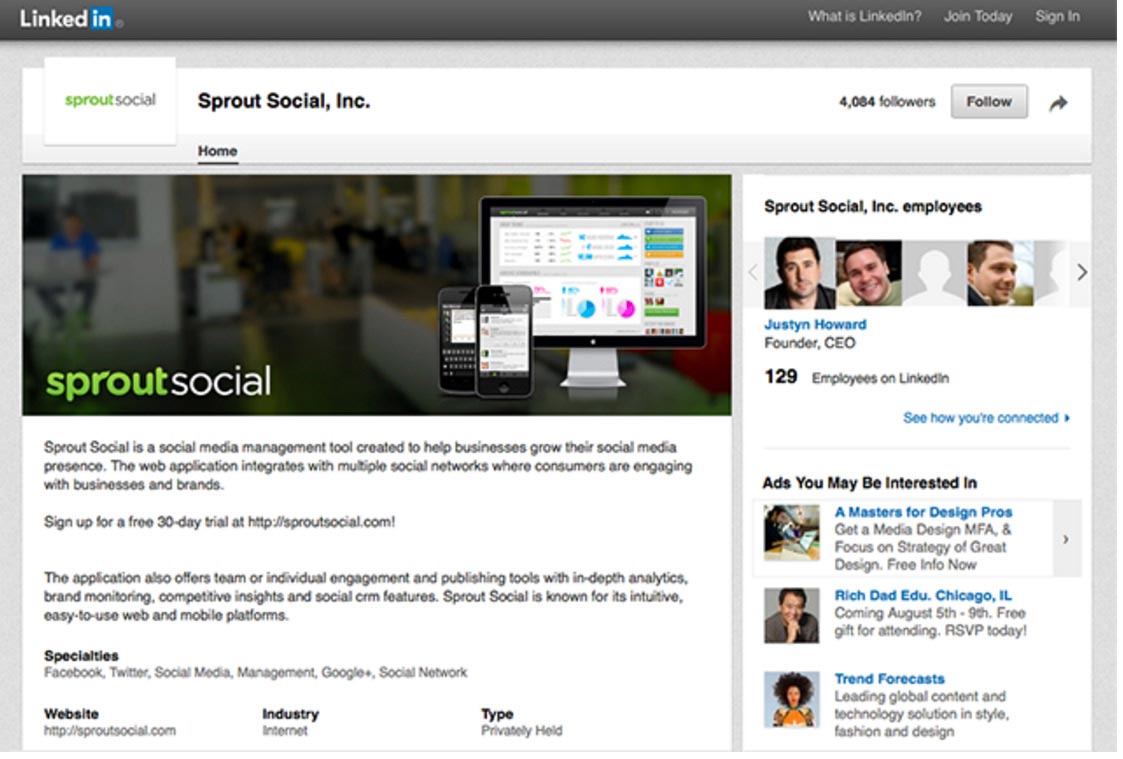
A Company Page increases the visibility of your business and enables you to have followers.
Sponsored Updates support likes, shares, comments and follows – bringing the opportunity for third party validation from friends and colleagues. Here’s where you can engage users with offers for white papers, webinars and podcasts to build awareness, create ongoing engagements and establish relationships.
Bear in mind that users can dislike your ads and make negative comments. So don’t think of them as a way to makes quick sales. Consider them as long-term relationship builders.
Basic ads. These won’t appear on smartphones or tablets, but they do provide a quick way to promote offers. At their simplest they are text only, but for a little extra spend you can include simple videos, images and social options. Don’t dismiss basic ads, though: Target right and message well and you can get good results. They’re also more affordable than Sponsored Updates.
Building effective ads In LinkedIn advertising
Both basic text ads and Sponsored Updates offer complete bid and budget control, and good targeting and content options. Here are the basic steps:
Step One: Create Your Ad
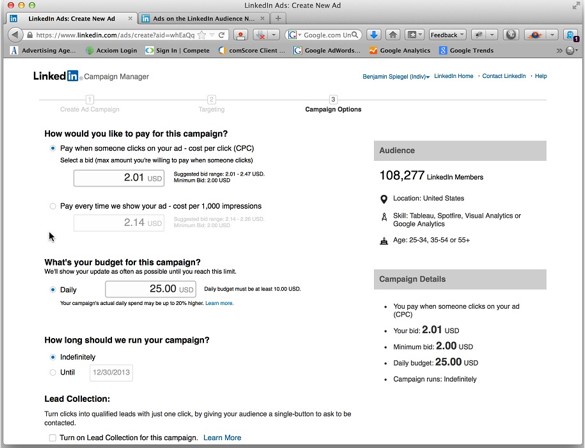
LinkedIn’s interface walks you through building your ad. Click the appropriate fields to name your campaign, choose ad type and format, and then enter the headline, copy and the destination your ad takes users to.
Step Two: Target Your Audience

Now it’s time to apply the homework you’ve done on your target audience. Start pointing and clicking on the options; pop-up windows offer layer after layer of ever-more granular options enabling you to click to exactly the users you want to reach.
Step Three: Your LinkedIn Advertising Budget
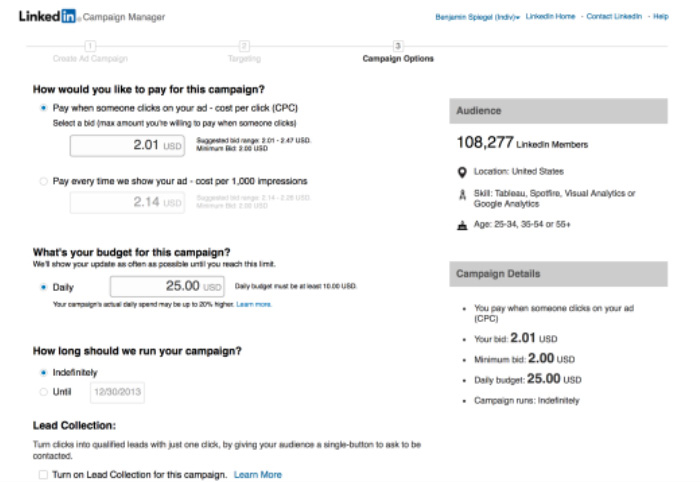
Remember to create those minimum and lifetime budgets! The minimum daily budget is $10. And you can bid on either a Cost Per Click or Cost Per Thousand Impressions (CPM) basis. Prices range from $2.01 to $2.47 and you’ll see a minimum suggested bid.
Important: The look and messaging of your lander needs to connect people immediately with your ad!
The best ad in the world won’t do you any good if the landing page it leads to doesn’t instantly pay it off in respondents’ minds. And we mean instantly. Because if there’s any dissonance, viewers will hesitate before reading on. And he who hesitates is lost to you, the advertiser. So make sure things match up and pay off!
One final thought: Consider the LinkedIn Client Service Team
If you have the budget, LinkedIn advertising has the team for you: The LinkedIn Client Services Team. They’re expensive. But they will come up with creative ideas that will help ensure your campaign’s success. Plus, they’ll work with you to create richer, more customized options than are available with self-service.
Feel free to share this blog, LinkedIn Advertising – Best Practices, How to Use Basic Ads and Sponsored Updates. We only ask that when shared no changes are made, and credits are given to the authors.
About the Authors

John Thyfault
This post was authored by John Thyfault, Vice President of Search & Social Strategy, and Laurie B. Beasley, President of Beasley Direct & Online Marketing.
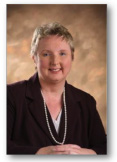
Laurie B. Beasley

